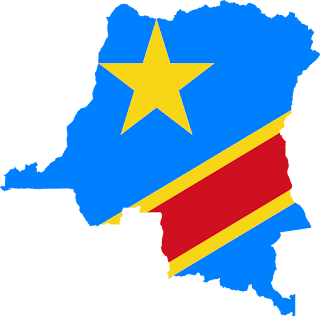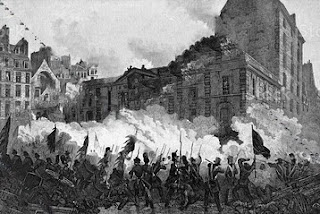Contad's use of symbols in Heart of Darkness
 |
Democratic Republic of Congo |
The first important symbol in the novel is the quest or journey. At one level the journey is through the river of Congo in the heart of African continent and on a deeper symbolical level the journey is evidently within oneself and amounts to self-discovery and realisation. The journey is also that of a so-called civilized person (i.e. Marlow) into the land of savagery and also to understand the enigmatic character of Mr Kurtz who is believed to have reverted back to savagery from his position as a once-civilized person in his homeland. These dimensions make the novel resemble a exciting travelogue and at the same time, the novel becomes a psychic journey through "cold, fog, tempests, disease, exile and death" as Albert J. Guerard mentions in his article entitled The Journey Within. Joseph Conrad fuses the topographical journey through the heart of Africa with the psychic journey, as emblematized in the loaded language as of the following: "going up that river was like travelling back to the earliest beginnings of the world when vegetation rioted on the earth and the big trees were kings."
Light and darkness in their fusion or in their contrast operate as important symbols throughout the novel. For example, the particular time and place where, the protagonist, Marlow starts narrating the story are very significant. Anchored on the mouth of River Thames where it has just fallen into the sea symbolizing special restriction and special sublimation, Marlow begins this story just where the sun is about to set with darkness gradually descending from the corners of the sky. This twilight, bidding adieu to the light and welcoming darkness, says us to be mentally prepared for "nothing but placid staring" that would thematically and technically traverse us through the extended stretches of juggling between the light and the darkness at multiple levels.
-----------------------------------------------------------------------------------------------------
1. Conrad'S portrayal of wild AFRICA in HEART OF DARKNESS
2. Auto-biographical elements in David Copperfields
------------------------------------------------------------------------------------------------------------
As the character Marlow is journeying into the land of the African people, the imagery of black becomes all-pervasive. Even before Marlow had started his journey, he witnessed two women in the outer office of the company in Bassles that is hiring him, knitting black wool. During his journey through Congo, Marlow sees several deserted hurts with wholes on their roofs which looked black from far. The interplay of light and shade often made Marlow discern 'shiny patches on the black creek'. Significantly enough the two hens that Kurtz saw before his death are also black in colour. The jungle which Marlow sees on both sides of the river Congo is not merely petrified forests but so very 'dark green' that they appear almost to be black. Marlow even sees during his visit to Kurtz's station house 'black sunken skulls upon the fenced post'. The difference in skin colour, i.e. the European white colour skin versus the tanned black skin tone of the African people, is a symbol of contrast that opens up not merely the difference of racial identity but also ultimately the message of epithet that the flow of life does not make any discriminations in skin tone. All such symbols indicate the topsy-turvy-dom of values and ideas of the land that is highly unfamiliar and mysterious.
Many of the characters in the novel have symbolic roles. The character of Kurtz himself is symbolic. He emerges as a person who has renounced the European civilization and embraced the African civilization. In that way, he has forsaken his brothers (i.e. European people) to embrace the strangers (African people). It is difficult at the beginning to understand whether Kurtz actually symbolises a saint or a sinner, a civilized person or a primitivist. But finally Kurtz symbolizes the Grail at the end of Marlow's quest.
The character of the manager symbolizes the hollowness and moral importance of either the European companies operating in Africa or the pilgrims coming there. The manager further symbolizes hypocrisy and mean-spirited avarice indicated by his philosophy of life౼ “Cautiously, cautiously—that’s my principle”. The two women knitting black wool symbolizes the blind Atropos who in Greek mythology, chose the manner of death and ended the life of mortals by cutting their threads. From a mythical perspective, the two women also symbolize Cirnaean and Sibile who are said to be guards at the gate of death and hell.
The
pilgrims who travel through the river Congo symbolize coward and cruel
destructiveness with their empty mask-like appearance. They are only outwardly
pilgrims but inwardly devoid of aims and values. The accountant symbolically
manifests European imperialism on one hand but is inwardly hollow and looks
like a "hairdresser's dummy". The native woman, probably the mistress of
Kurtz, signifies Kurtz’s passionate involvement with time and flesh. Her
symbolic role enhances automatically when she is equated with the vegetation of
the jungle. Therefore we find that most of the characters in the novel
officiate at highly symbolical levels too.
Along with the symbolic
contrast of light and darkness as well as black and white, we also have the
clashing counterpoints of the primitive setting of Congo contrasted with the civilized
setting obtains. Similarly, Kurtz’s native mistress or love interest comes in
sharp contrast with his pale-faced and dignified fiancé whom Marlow meets
towards the end of the novel. In the same way, the mysterious but stimulative
darkness of Africa is contrasted against the white monolith of a modern city
like Brussels which appears to be a grave-yard in the eyes of the narrator.
These symbolical themes
also surface at multiple parts of the novel with diverse effects. They are the
theme of restraint, the theme of the hollowness of modern Europe, its people and
its civilization, and the theme of isolation. The novel typifies the truth that
whereas Kurtz is doomed by the lack of restraint, Marlow is saved by it. The novel
also indicates how Europe has rendered itself hollow through its colonial methods
and has lost everything positive and enterprising. Both Kurtz
and Marlow represent elimination and isolation in different respects. Kurtz was
isolated for the time being when he forsook European civilization and embraces
the primitiveness of Africa. Similarly, Marlow is isolated due to his sensitivity to Buddha-like realization which makes him realize the loopholes of the European
civilization.




No comments
Thanks for your valuable opinion. Your comment inspires us a lot to do better time and again.